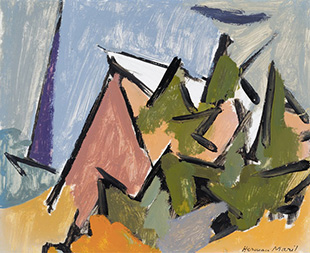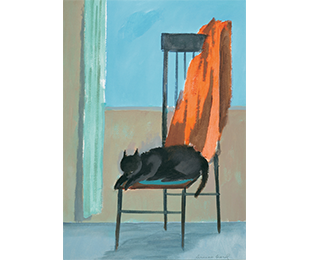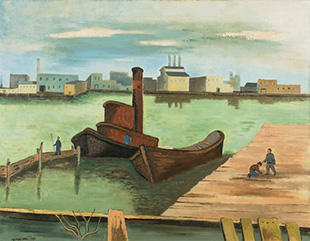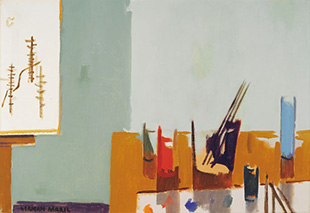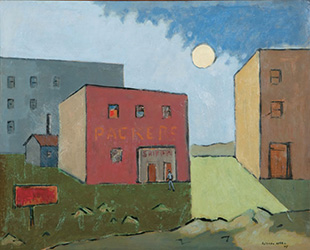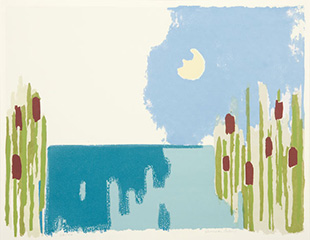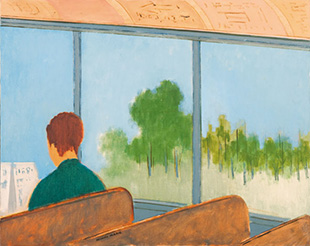Herman Maril
Cape Forms
1950s
oil on paper
15 x 16 inches
Maryland Artist Collection
Gift of Kay Hillman
Discover Herman Maril's life's work—and dream.
Herman Maril (1908–1986) was a Baltimore-born artist who painted seascapes, interiors, and landscapes in a pure, lyrical, and profound style. From his teens, and throughout his life, he single-mindedly pursued his art.
"The sources of my work have been a response to nature and the world around me," Maril once said. "I am interested in the language of paint, and my ideas must be expressed in terms of space concept on the plane of the canvas. I want my paintings to have an organic 'oneness' which should be the result of a constantly growing understanding and feeling for the lyricism possible in the plastic units of the picture struggle."
Herman Maril: The Early Years
Maril received early training at the Maryland Institute of Fine Arts, worked during the Depression years on Federal projects, and painted as opportunity presented itself during his World War II military service. After the war, he began his career as a teacher-painter at the University of Maryland. He exhibited widely; was represented by Washington, Baltimore, and New York galleries; and received numerous prizes and awards.
Today Maril's work is included in more than 60 museums, including the Baltimore Museum, Bronk Collection at Adirondack College, Butler Institute of American Art, Cape Museum of Fine Arts, Cleveland Museum, and Corcoran Gallery. Maril's pieces can also be seen at the Hyde Collection, Phillips Collection, National Academy of Design, Provincetown Art Association, Smithsonian's National Museum of American Art, San Francisco Museum, Whitney Museum, Walters Art Museum, Wichita Art Museum, Worcester Art Museum, and many other museums throughout the United States and Europe.
"Herman Maril was an artist of extraordinary stature," says Lou Zona, director of the Butler Institute of American Art. "I underscore the description 'American' because Maril personifies the art of this country at mid-century—highly individualistic, expressive, and rich in social relevance. Maril represents the innovative spirit of an American painter who, while fighting the overwhelming influence of Picasso's cubism and various European expressionistic modes, pounded out an American vision inspired by the uniqueness of this culture.... Our admiration for the talent of Herman Maril could not be greater for in him we see the very best America has to offer."
From the beginning, Maril's art showed a consistent development: it was nature based, abstractly organized, and simplified in form and content. The noted artist and critic Olin Dows, in a 1935 article on Maril in the American Magazine of Art, noted that although showing influences from Picasso and "modern geometric painters," the artist had already embarked upon a highly personal style. Dows wrote about the then 26-year-old artist: "Herman Maril's painting is reserved, and like most good painting it is simple. He is interested in the essentials. Each picture has its core; each is beautifully conceived and organized... Each is a distinct mood.... The subject is 'brought out.' It is clothed in a certain poetry, a certain meaning that is essentially pictorial."
The late Howard Wooden, former director of the Wichita Museum, observed that Dows warned of two dangers in Maril's works: the exaggeration of understatement and the neglect of detail. Wooden added, "The features proved to be among the most distinguishing qualities and the greatest strengths throughout Maril's career. In retrospect, it is evident that the charm and excitement of Maril's work have to no small degree rested on his consistent use of understatement and his intentional elimination of superficial incidentals."
Post WWII: Baltimore and Cape Cod
After the war, Maril's very personal style continued to evolve, both restrained and daring, both understated and richly colorful. "In his later years, Maril's paintings became more effortless in appearance, broadly simpler, yet in detail more delicate and more balanced, and with color that is more functional in pattern as well as depth," said Charles Parkhurst, former deputy director of the National Gallery in 1977.
While Cape Cod and Baltimore were where Maril created much of his work, he was also influenced by trips to Mexico, California, the Adirondacks, the Southwest, Italy, Spain, and Portugal. It was, however, on Cape Cod that he received an early major break, getting discovered by the late Duncan Phillips, founder of The Phillips Collection, which currently owns 13 of Maril's works. Through that exposure, leading to exhibitions in New York, Maril was selected as a Works Progress Administration (WPA) artist and was commissioned to paint murals in the post offices of Scranton, Pennsylvania, and Alta Vista, Virginia. He also had a painting selected by Eleanor Roosevelt to hang in the White House and was included in exhibitions at the Museum of Modern Art, the Brooklyn Museum, and the Carnegie Institute. In 1967, the Baltimore Museum published a monograph book, entitled Herman Maril: A Monograph, in conjunction with a one-man exhibition of his works. The Institute of Arts and Letters honored him in 1978.
"Throughout his entire career, Maril painted space and, always with the unique artist's sense of joy... for his subject and his art," said Sheldon Hurt, curator of the William Bronk collection at Adirondack College. Since 1930, Maril's work has been featured in more than 50 one-man shows at galleries and museums around the country. "His rather quiet yet richly lyrical color and his always well composed compositions have great lasting quality," said the late Adelyn Breeskin, former director of the Baltimore Museum.
Art historian David A. Scott, former director of the National Collection of Fine Arts and the Corcoran Gallery, says of Maril: "His early experiment with cubist devices gave him the ability to deal with landscape forms selectively and analytically. Building on this, after the war, he developed an increasingly personal style, expressed in direct, vigorous ink drawings and arrestingly simple, evocative oils. What meets the eye in his work is delightful but we realize the apparent simplicity is deceptive. The process of simplifying, a thoughtful and intuitive elimination of detail is important. Starting in his later painting with a motif in nature that moved him, Maril broadened the statement, simplified space and form, reconciled them to the picture plane, eliminated distracting elements and tensions, and achieved a harmony that focuses and enhances pictorial energy. The result, in his most successful work, conveys a deep sense of peace and harmony."
William Bronk, poet


